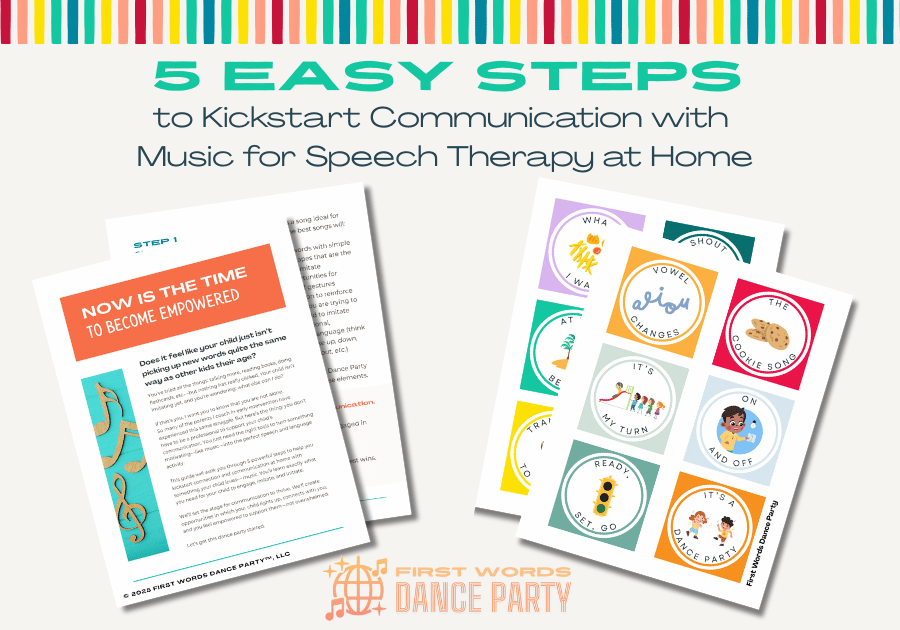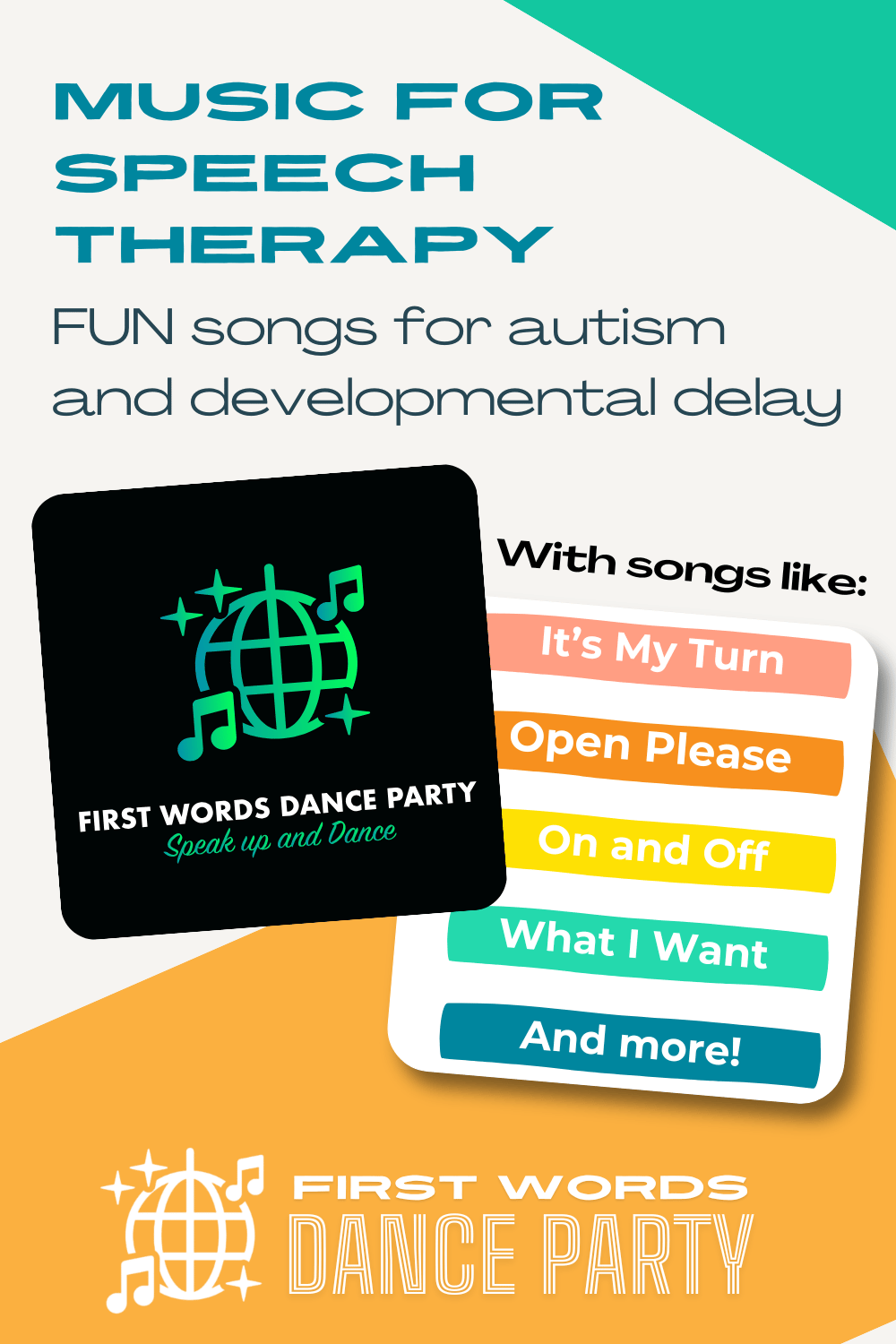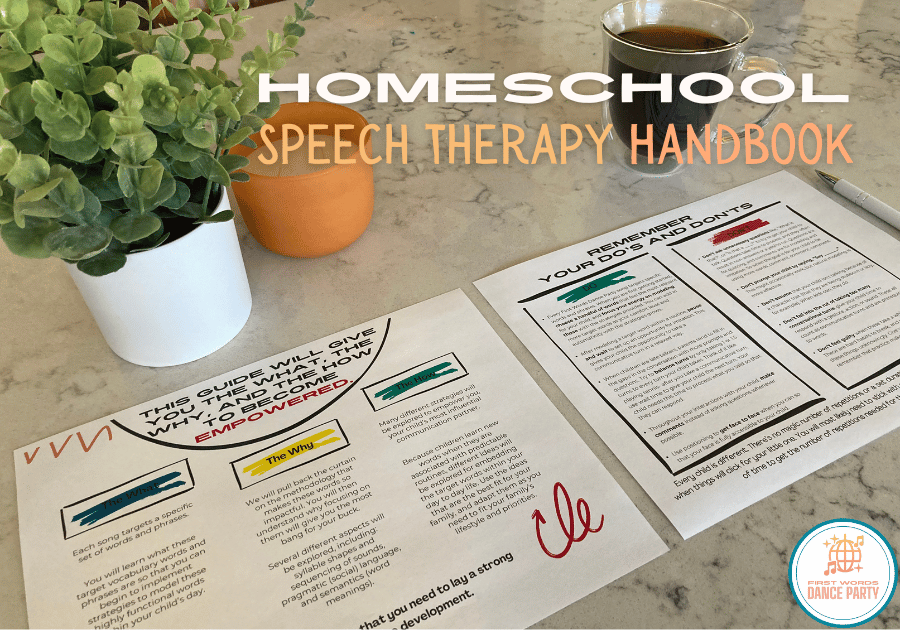Developmental Delay vs Autism: How to Compare and Accomplish Speech Success
- 0 comments
When your child isn’t hitting developmental milestones quite in line with their age, it’s natural to wonder whether it’s a developmental delay vs autism.
It can feel overwhelming as you wonder if your child will eventually just catch up, or if there could be something more going on. Developmental delay and autism can look similar in the early years, and sometimes the line between them isn’t perfectly clear.
If your child isn’t using many words yet, you may be unsure of what to do and what not to do- and you’re not alone. Many parents I coach in early intervention feel stuck, frustrated, or overwhelmed when their child isn't talking.
That’s why I started creating music for speech therapy that weaves in the strategies we use everyday in early intervention. I created First Words Dance Party® as a way for parents to support language through speech therapy songs kids love, even while waiting for evaluations or answers.
You can download a free guide to discover 5 easy, parent-friendly steps to use music for speech therapy at home to spark connection and communication with your child. As a bonus, you’ll receive song boards with cards for every First Words Dance Party® song, so your child can make choices and discover the power of their voice.
In this article, we’ll answer these questions:
What is a developmental delay?
What is autism?
Developmental delay vs autism: how can I tell the difference?
Finally, we’ll explore some strategies you can use today to help your child find their voice. Here we go!
What Is a Developmental Delay?
A developmental delay simply means that a child is gaining certain skills more slowly than expected for their age. It’s not a diagnosis—it doesn’t explain why development is delayed.
Instead, it’s a descriptive term that tells us there is a lag in one or more areas of development.
Child development happens across five developmental domains, or areas:
Communication (expressive language and receptive language)
Cognition (play skills, problem-solving, early thinking skills)
Motor (gross motor like crawling or walking, and fine motor like grasping toys)
Adaptive skills (daily living skills like feeding and dressing, safety awareness, and advocating for needs)
Social-emotional skills (how children engage with others, express themselves, and regulate)
You can learn more about these areas and what is expected for your child’s age with on the CDC's website.
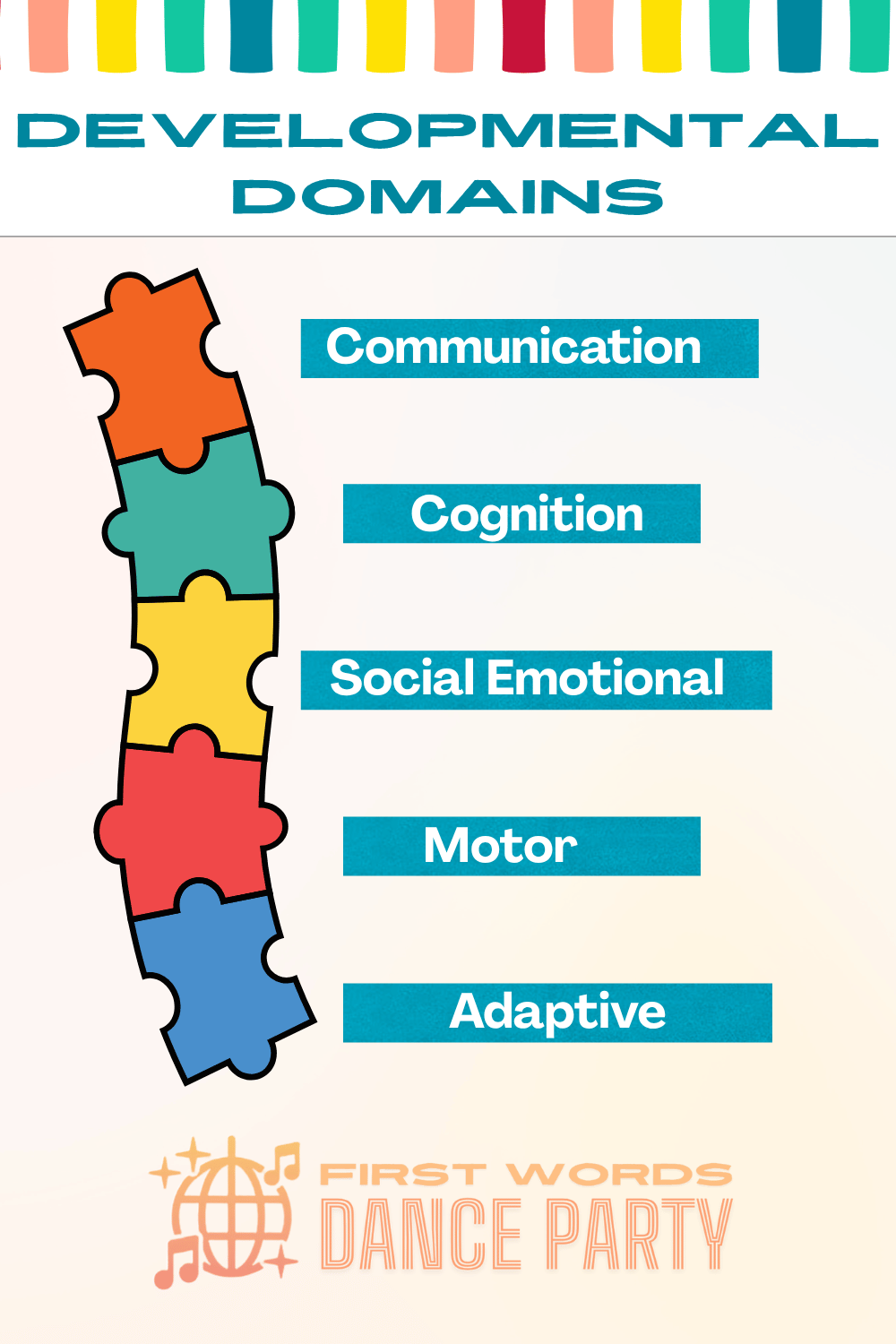
Signs of developmental delay
When children are infants, motor skills are often the first milestones that parents notice. An infant who isn’t rolling, sitting, crawling, or walking in line with typical milestones may be described as having a developmental delay in motor skills.
As children reach their first birthday, the focus shifts toward communication. This is where parents are most likely to notice a developmental delay in regards to a child’s speech and language skills—like not yet using 10–50 words by 18 months or combining words together by 24 months.
For speech and language milestones, you can check out these fabulous communication milestones from ASHA (The American Speech-Language-Hearing Association).
Global developmental delay
When delays occur across two or more areas, it is sometimes referred to as a global developmental delay.
It’s common for a child with a speech delay to also have a delay in another area, such as adaptive, cognitive, or social-emotional skills.
But in toddlers, these other domains can be harder to recognize because they are a bit more nuanced. Speech and motor delays are usually the easiest to spot because they are so visible, while social-emotional delays may be more subtle in the early years.
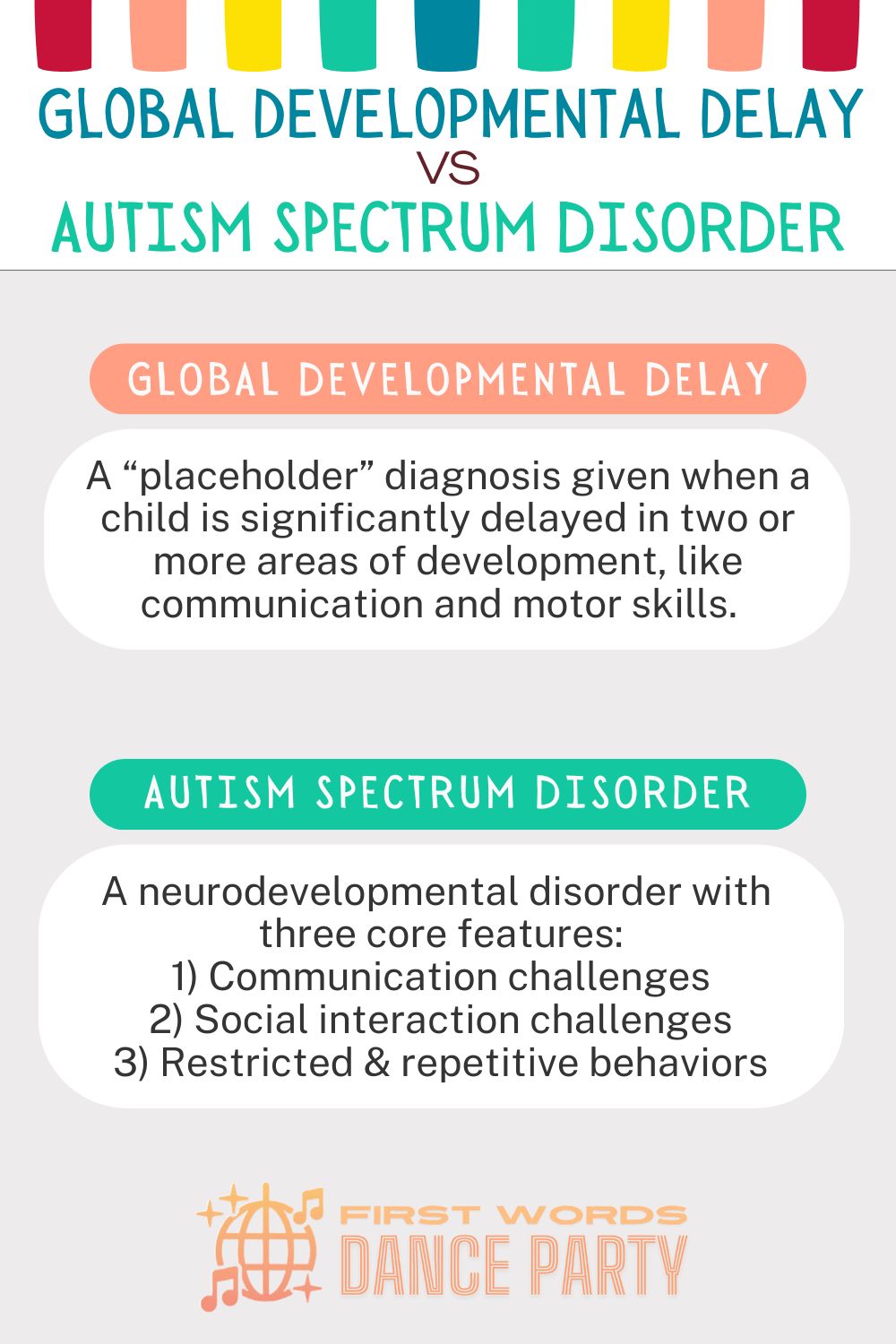
Developmental delay causes
Many times, the cause of a developmental delay is unknown. Some children will close the gap between their skills and their same-aged peers by elementary school. Others will continue to need support.
There are many underlying (and often undiagnosed) conditions that are known to hinder development. Some of these are:
Chronic ear infections or middle ear dysfunction
Genetic syndromes, like Down syndrome or Fragile X syndrome
Premature birth, low birth weight, or birth trauma
Autism spectrum disorder (ASD)
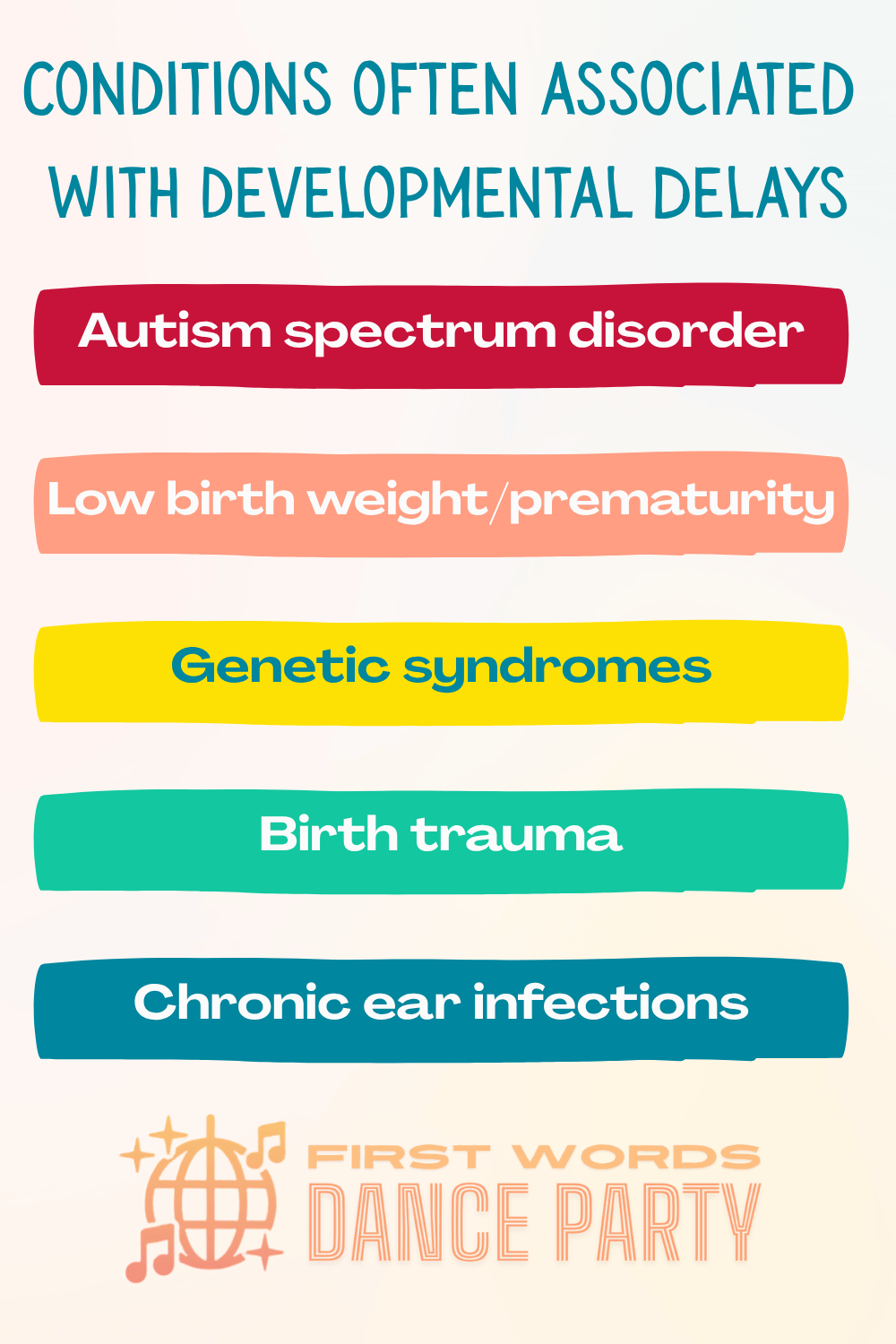
What Is Autism?
Autism is a neurodevelopmental difference that shapes how a person communicates, interacts, and experiences the world. It isn’t just about being “behind” on milestones—it’s about having a different developmental pathway altogether.
A note on identity-first language
In this blog, I use the terms “autistic” and “on the autism spectrum,” reflecting preferences shared by many in the adult autistic self-advocacy community. According to a 2015 study in the journal Autism, identity-first language is often preferred because it recognizes autism as a core part of a person’s identity—not something to be separated from them.
Autism is defined by three core features
Communication differences – including differences in how language is used to share ideas, to make requests, or to start and maintain a conversation. Many autistic children are late to talk and benefit tremendously from Augmentative and Alternative Communication (AAC), sign language, and visuals.
Social interaction differences – including differences in how autistic children initiate or respond to social connection. This may include a preference for playing alone or limited back-and-forth interaction.
Restricted and repetitive interests and behavior – including things like strong interests in certain objects, shows, or topics, and a need for routines and predictability that bring comfort to autistic children.This also includes sensory differences, such as being very sensitive to nonpreferred foods or seeking out lots of movement.

No two people are exactly the same
Autism exists on a spectrum, which means children can have very different strengths and support needs across these three areas.
Some autistic toddlers may use only a few words but have stronger understanding. Others may have big vocabularies but struggle with using language to initiate with others and to use language for different functions. Some autistic toddlers are always on the go and have a hard time sitting for meals or play because their bodies are wired to need constant movement.
It’s important to remember that no two autistic children are exactly alike. While one child might find comfort in the repetition of stacking items or lining them up as they play alone, another may actively seek out peers and new experiences, but need help to understand how to start and maintain an interaction appropriately.
So how do you know if your late-talking toddler is demonstrating characteristics of autism vs developmental delay?
We look for a constellation of characteristics.
Seeing the constellation
When a toddler or preschooler demonstrates several characteristics within those three core areas, then we start to see the “constellation”. We can see how the different challenges and strengths a child is demonstrating may actually be representative of the three core features within the autism triad.
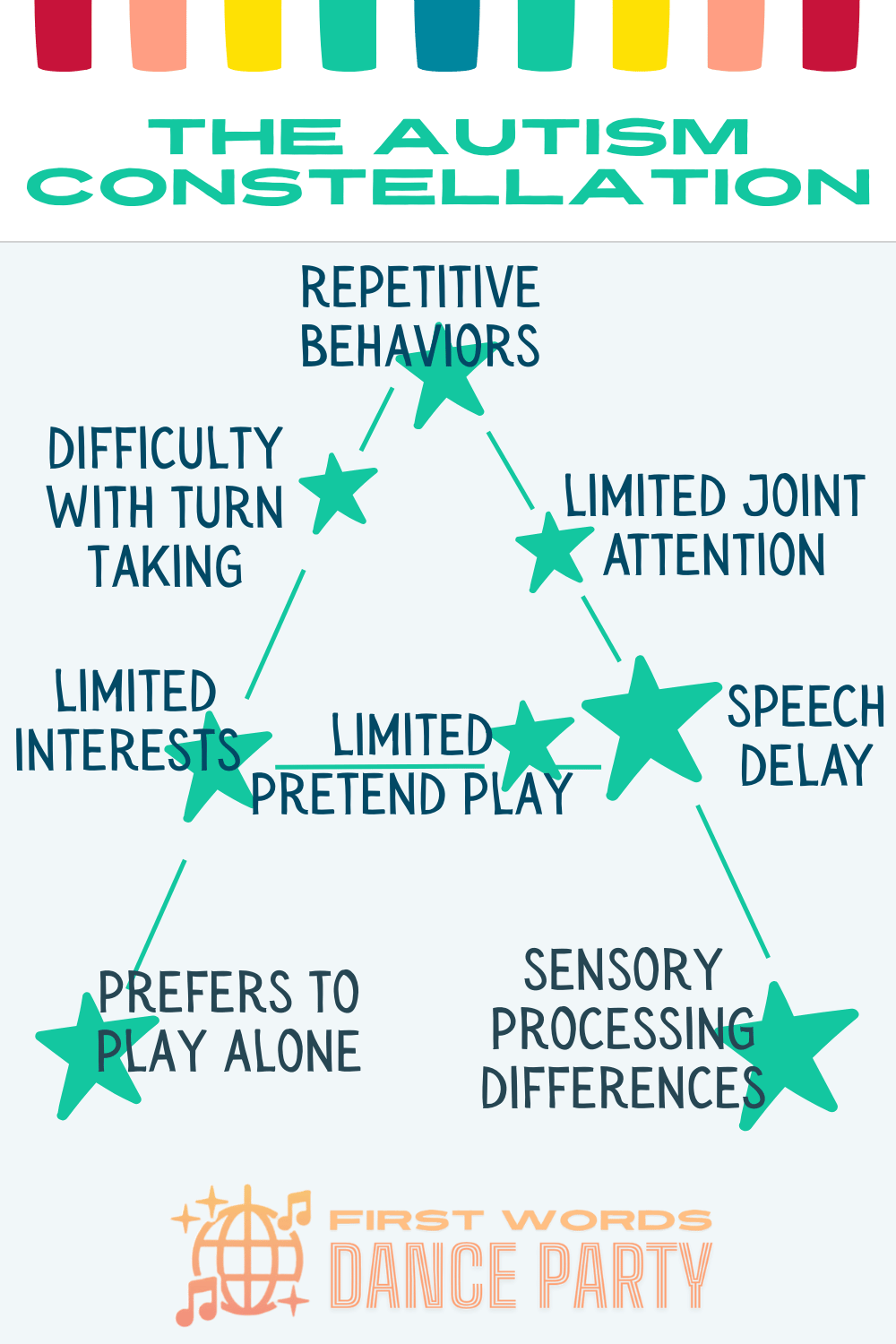
I really like the constellation analogy. When you’re a parent of a toddler or preschooler, it can be incredibly hard to try to make sense of autism when your child is so young. The constellation analogy helps to illustrate how autism is really a pattern of characteristics.
Everyday examples in toddlers
Here are the most common real-life examples that I see every single day in my work with toddlers on the autism spectrum in their homes:
Not yet using a wide variety of gestures like pointing, waving, giving high fives, or nodding “yes”
Had a few words they used to say, but then stopped saying them
Hard to redirect/distract from strong interests in specific objects, like shoes, spoons, the alphabet/numbers, or sticks (just a few examples, but a child on the spectrum could be very enthusiastic about any object that brings them joy)
Not yet playing with a wide variety of different toys in different ways
Lining up toys or other objects, or taking/dumping items out of a container and then putting them back in again. This often happens in place of flexible, pretend play.
Not yet responding to name or following simple directions like “Put your cup in the sink”
Highly selective eater
Using echolalia (repeating lines from songs or shows), but has a much harder time imitating words used by other people within regular activities
Preferring to play alone when peers are present, or wandering away from a parent or peer when they try to join in
Slightly behind with gross motor skills, like walking up and down the stairs
Pulling a parent to something they need help with, like opening the fridge, or placing something in a parent’s hand they need help with, like opening a snack— without looking at the parent’s eyes to communicate
Struggling with transitions in a way that is more intense and frequent than typical for toddlers
Strong visual learning skills; notices small details like shadows and reflections
Loves items that spin, like fans and wheels
Cries and becomes anxious in new or unfamiliar places and around unfamiliar people
You might look at some of these things and think, “That’s just normal toddler behavior,”- and this is where the autism constellation really helps. If a child demonstrates just one or two of these things- yup, that can absolutely be normal toddler behavior.
It is when we see several different characteristics across the autism triad (communication, social, and restricted and repetitive behavior) that we see a pattern that starts to look like the constellation of autism, vs developmental delay alone.
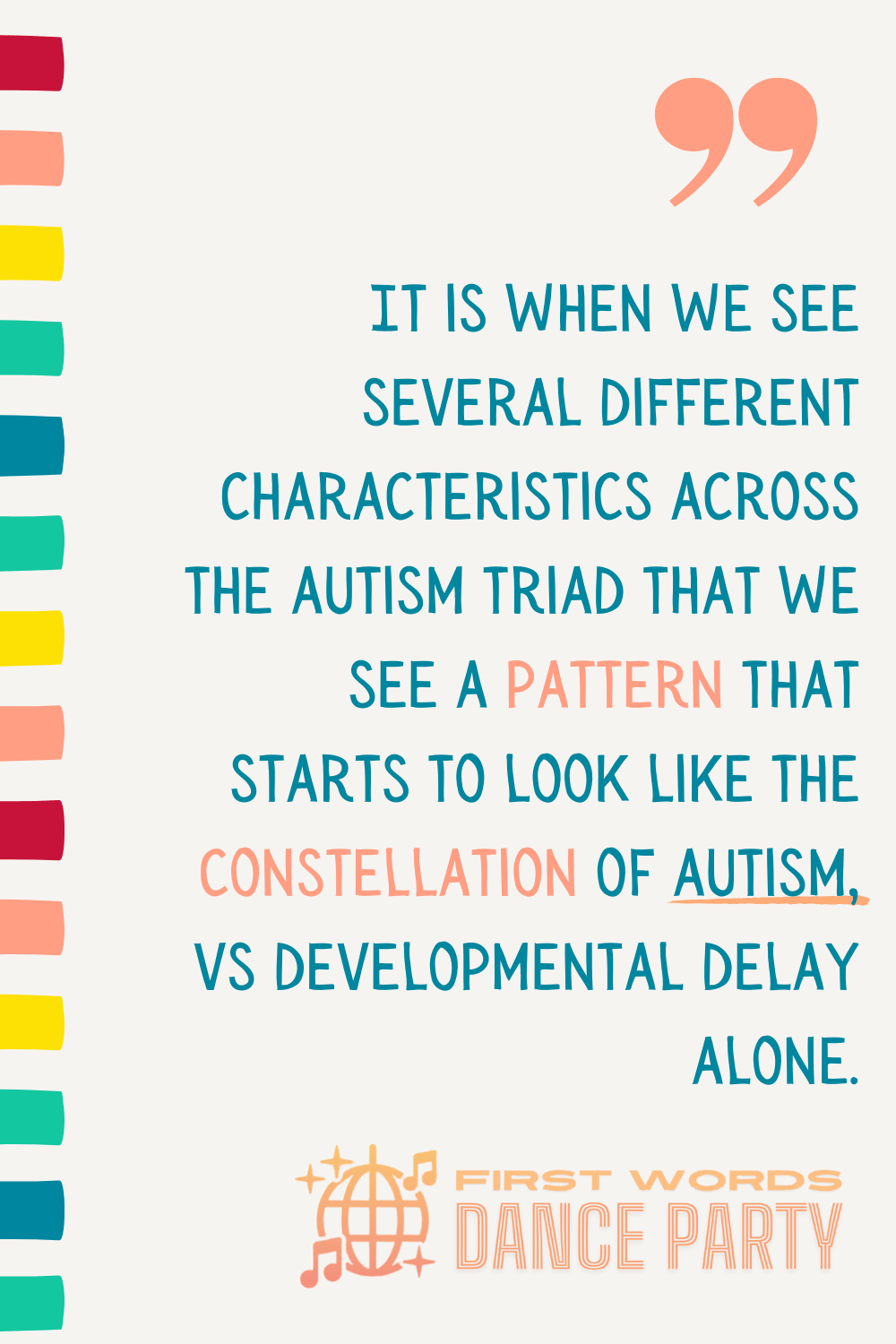
Every child is different
This list is by no means exclusive- these are just the most common characteristics I see every single day when I go from home visit to home visit. Once you have a better understanding of the learning style of autism, the specific examples kind of “click” into place.
Remember that no two children are exactly alike and that autism can also look very different in boys than in girls. Girls tend to appear to be shy or quiet and don’t necessarily do the more “classic” repetitive behaviors, like lining things up- but they may look for order and routine in other ways.
For more information on how autism can present in girls, check out this article from the Child Mind Institute.
Developmental Delay vs Autism: Key Contrasts
Developmental delay and autism can look alike in the toddler years, but they are not the same. A developmental delay means that a child is moving forward on the same developmental progression as other children, but at a slower pace.
The term is most often used in early childhood, and it doesn’t explain why the delay is happening. Some children will catch up to their peers over time and close the gaps in skills. Others will continue to need support, and as they grow older, they may receive a medical diagnosis such as autism or another condition.
Autism, on the other hand, is not just about slower progress. It is a lifelong neurodevelopmental difference that shapes how a child communicates, interacts, and engages with the world. Autistic children may reach some milestones right on time—or even early—while showing differences in social connection, communication style, and patterns of behavior.

Diagnosing autism vs developmental delay
Since an autism diagnosis is based on behavioral observations rather than a lab test, working with professionals who specialize in developmental assessment is key. Research shows that children diagnosed with autism before around 2½ years of age tend to make larger gains in language, social connection, and overall cognition than children who are diagnosed later.
In short, developmental delay describes a slower than expected skill growth in the early years, while autism describes a different developmental style across the lifespan.
Developmental delay and autism can overlap
Here’s where it gets tricky: Even with clear definitions, developmental delay and autism often overlap in early childhood.
Most (but not all) toddlers and preschoolers who are on the autism spectrum do have developmental delays—especially in areas like communication, social-emotional development, and/or adaptive skills.
But not all developmental delays mean autism. A child may have a speech delay or a motor delay without being autistic.
This overlap can be confusing for parents, but it doesn’t change the most important takeaway: whether your child has a developmental delay, autism, or both, early support makes a huge difference.
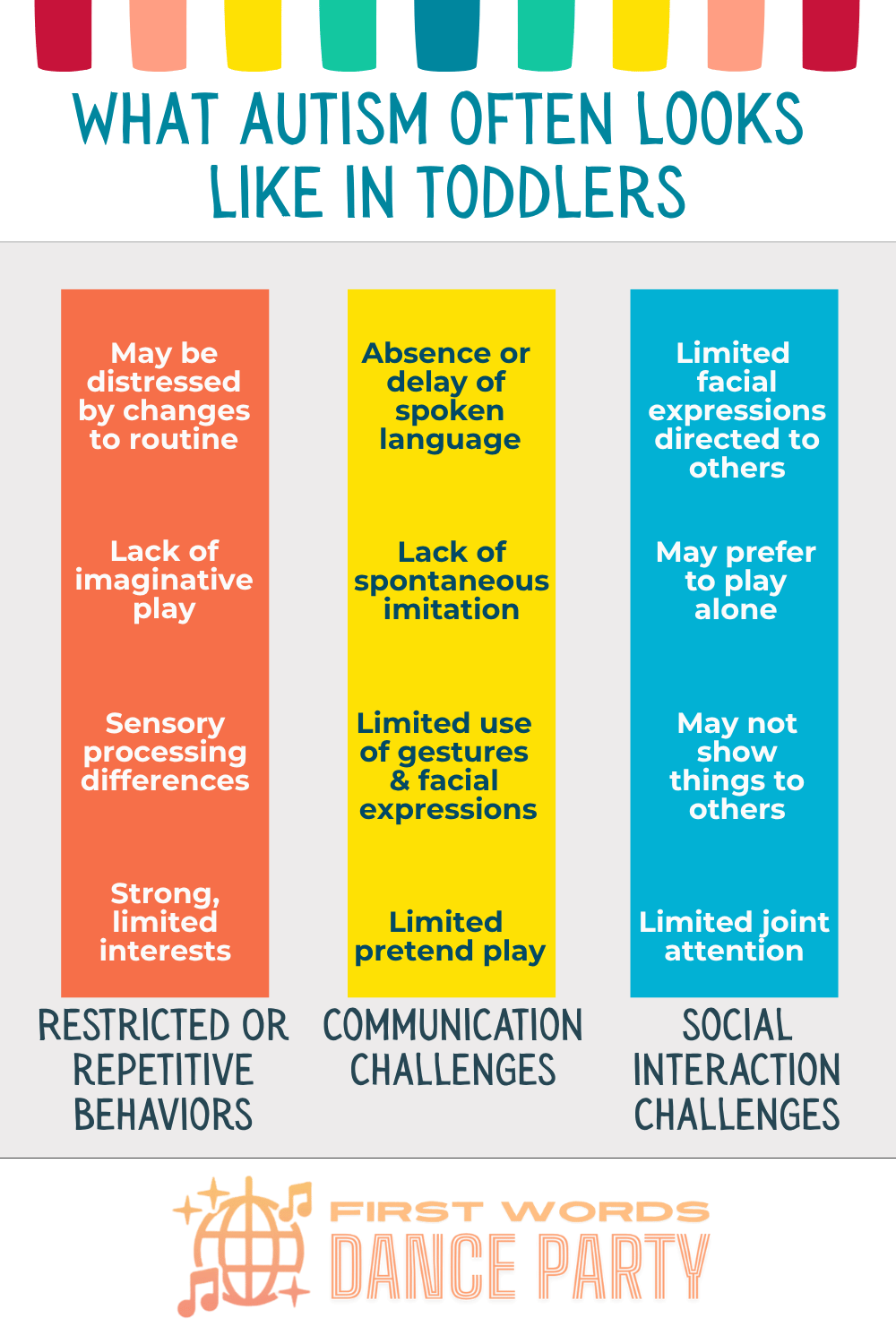
How do I know if it’s autism or developmental delay?
This is a time to trust your intuition. The only way to know for sure is to seek out an evaluation for your child.
Earlier identification is associated with better outcomes, and of course you want the absolute best outcome for your kiddo.
Whether your child’s communication struggles are due to developmental delay or autism, what matters most is responding to your child’s needs today- and you don’t even need to leave the house to start.
Speech therapy music for developmental delays and autism
If you’ve made it this far, you might be holding a mix of emotions—worry about the future, questions about what’s happening right now, and hope that your child will find new ways to grow.
You’re not alone in that.
As an early interventionist, many of the parents I work with find themselves eagerly looking for support while also waiting and wondering. It’s the daily moments of wondering:
How do I help my child learn to communicate?
How do I get my child to imitate me?
How can I help my child to engage and connect with me more?
For all of the parents working through these very same struggles, I created First Words Dance Party®- fun, catchy music written with speech therapy strategies built right into every lyric, to empower parents and caregivers.
Fun, catchy speech therapy songs specifically for autism and developmental delay
Every song is built around simple, functional language that parents can model easily across daily routines. You’ll hear phrases like “help me,” “shoes on,” “my turn,” and “open please”—the kinds of words that carry over seamlessly into real life.
The lyrics also highlight early developing syllable shapes, which are the building blocks of spoken language. Consonant-vowel words like go and me, vowel-consonant words like up and on, consonant-vowel-consonant words like push and pull, and reduplicated patterns like bye-bye and night-night. These carefully chosen words make it easier for children to imitate.
These songs meet children right where they are—whether their communication differences are connected to developmental delay, autism, or both.
Speech therapy song examples for developmental delays and autism
The music isn’t just for kids—it’s for parents, too. Unlike many traditional nursery rhymes, these songs are designed to be enjoyable for adults, too. And every lyric carries an intentional strategy.
Here are a few examples:
The Cookie Song: This kid favorite targets the core words yes and no, along with the words eat, want, what, doggie, and of course, cookie! This one is perfect for kids who aren’t yet gesturing or saying yes and no.
Ready, Set, Go: This one uses a powerful strategy, called an anticipatory set, to promote engagement. It targets the opposite pair stop and go, along with the words push, pull, bubbles, uh-oh, oh no, more, and I.
What I Want: By hearing the powerful phrase "I want _____" repeated with motivating examples, children learn how to make requests for their favorite things—like bubbles, going outside, chicken nuggets, veggie straws, and Goldfish crackers. Check out the video below, which uses AAC (Augmentative and Alternative Communication) so kids can see this phrase put into action.
You can stream First Words Dance Party on Spotify, YouTube Music, Apple Music, and anywhere else you get your music.
If you’ve ever felt the weight of trying to support your child’s speech progress at home—wondering “Where do I even start?” or feeling like the things you have tried just haven’t been successful—you’re absolutely not alone. Trying to navigate speech therapy home activities that feel meaningful and manageable (rather than another exhausting to‑do) can leave you drained, second‑guessing, and wishing for something simpler.
That’s where the Homeschool Speech Therapy Handbook comes in. Designed specifically for parents (not trained therapists) who want real‑life tools, this guide breaks down exactly what to do, why it works, and how to bring speech‑therapy practice into everyday moments—snack time, bath time, play time—without turning your home into a clinic.
Framed within a song-by-song breakdown of the Speak up and Dance album, you’ll discover how to apply the strategies within each song to real life for easy speech therapy practice at home. You’ll move from feeling overwhelmed and unsure to feeling confident and connected—watching your child engage, communicate, and grow in ways that feel easy and natural.
Final thoughts on developmental delays vs autism
Sorting out developmental delays vs autism can feel overwhelming—but you don’t have to have all the answers today to begin helping your child thrive. Whether your child has a speech delay, has a global developmental delay, or is on the autism spectrum, what matters most is that the strategies you put into place are the right fit for their strengths and challenges.
Singing is one of the most powerful ways to support communication. And when music is designed with speech therapy strategies in mind, it becomes even more beneficial—it becomes a bridge to engagement and language.
That’s the heart behind First Words Dance Party®. These songs and resources were created to give parents an easy, joyful way to model language at home, so you can confidently model speech therapy strategies without the overwhelm.
Grab your free 5 Easy Steps to Kickstart Communication with Music for Speech Therapy at Home and see how music can spark communication and connection for your child—whether the journey ahead is shaped by developmental delay, autism, or both.
FAQ
What is the difference between developmental delay vs autism?
A developmental delay means that a child is learning skills more slowly than expected for their age, such as talking, walking, or problem-solving. Autism, on the other hand, is a lifelong neurodevelopmental difference that shapes how a child communicates, interacts, and experiences the world.
What is global developmental delay vs autism?
Global developmental delay is a term for when a child has delays across two or more areas of development, like speech, motor, cognitive, social, and adaptive skills. Autism describes being on the autism spectrum, where the differences are centered around communication, social interaction, and patterns of restricted and repetitive behavior. Some autistic children with high support needs also meet criteria for global developmental delay.
Can a child have both developmental delay and autism?
Yes. Many autistic toddlers and preschoolers also have developmental delays, particularly in areas like communication, social-emotional skills, and/or adaptive skills. Some children on the autism spectrum may have a global developmental delay, while others may only have a delay in one area.
Does a speech delay always mean autism or developmental delay?
Some children have an isolated speech delay (a delay in the area of communication) without other developmental concerns- but a speech delay is one kind of developmental delay. Many children with speech delays are on the autism spectrum, and delayed language is the first area in which parents will notice differences in their development. It’s important to look to professionals who can help determine whether a child is experiencing a speech delay, global developmental delay, autism, or a combination.
How can parents tell if it’s a developmental delay or autism early on?
It can be hard to know on your own, because both may involve late talking and slower progress with meeting developmental milestones. Since an autism diagnosis is based on observed behaviors rather than a lab test, it’s important to go with your gut and seek an evaluation if you’re unsure. Early diagnosis and intervention are linked with better outcomes.
